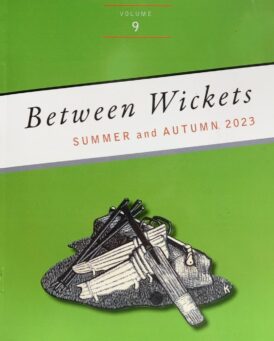Between Wickets 9
Martin Chandler |Published: 2023
Pages: 204
Author: Cardwell, Ronald (editor)
Publisher: Mansfield Publishing Ltd
Rating: 4.5 stars

It has been four years since Between Wickets 8 appeared, and that one came two years after issue 7. Let us hope that trend does not continue, and we don’t have to wait another eight years for Between Wickets 10, as I did not have to read very far into issue 9 to remind myself what an excellent journal of Australian and New Zealand cricket this one is.
And BW9 is somewhat wider than its predecessors, weighing in at a chunky 204 pages, although more than half of that pagination is taken up with just two features. An exhaustive listing of cricket books published over the last four years takes up 58 of the pages, and obituaries, four years worth again, take up another 54. If, as I fervently hope, Between Wickets now resumes its twice yearly pattern those sections will not need to be so substantial again.
The starting point is, naturally, an editorial, in which Ronald Cardwell acknowledges the four year delay, and reaffirms his commitments to the principles that drove him to start the journal in the first place. There follows an appreciation of the former Test batsman and international hockey player Brian Booth. A close friend of Cardwell’s the tribute to Booth, who sadly died on 19 May this year is, perhaps wisely, left to David Jenkins to write.
No edition of Between Wickets has failed to mention the importance to cricket literature of Ray Robinson, the man whose renowned 1946 book was the inspiration for the journal’s title.BW9 is no different, the contributors’ articles beginning with an appreciation by Gideon Haigh of his fellow Anglo-Australian David Frith, entitled A Nod to Ray Robinson.
There are a number of biographical pieces, always popular with me. I much enjoyed Cardwell on Bill Watson, a man whose fifth First Class match was his Test debut, the final Test of the 1954/55 Ashes series. Despite that the Watson Test career never really took off, and indeed was over three months later after three more appearances in the Caribbean. The likes of Watson can rarely justify a full biography but he, an interesting character, makes a marvellous subject for a monograph.
Much the same can be said of Stan ‘Steamer’ Wilson who, between 1968 and 1975, played five times for Western Australia and once for South Australia. Michael Sexton tells a fascinating story. The best biographical essay however is one that has waited 46 years to find its way into print. The writer is Bill Hunt, an orthodox left arm spinner capped once by Australia in 1931/32 against South Africa, and his subject is Hunt’s greatest friend in the game, Archie Jackson. It is moving stuff.
Then there is John Benaud on Lawrie Sawle, ‘The Colonel’, a decent batsman for Western Australia in the late 1950s who went on to enjoy a rather more distinguished career as an administrator, and as Chairman of the Australian selectors in the 1990s. Rob Franks looks at the life of New Zealander Bob Metcalf, who never played a First Class match, but who nonetheless played for a representative Australian side in England during World War Two.
Between Wickets has always been strong on the subject of cricket literature and BW9 is no different. Mike Coward writes about Vasant Raiji, the Indian writer and former First Class cricketer who died in 2020, a few months after celebrating his one hundredth birthday. There are detailed reviews of three books, Ken Piesse’s biography of Cec Pepper, Renato Carini’s labour of love on the subject of Victor Trumper and Greg Growden’s superb Cricketers at War. Finally on a bibliographical note Ian Grey takes a long look at the history of the various book awards that are available to cricket scribes.
The only living contributor to BW9 who is and always has been based in the UK is Richard Lawrence, who edits the extensive book review section of the ACS journal. Perhaps surprisingly given that background his piece has no direct connection to bibliography. What he does, largely through a detailed examination of contemporary writing, is provide an engrossing history of the evolution of the term ‘Test Match’.
A good journal always benefits from something a little bizarre, and I much enjoyed Dr Cyril Latimer’s explanation of ‘Pulpit Cricket’ as played by two young churchgoers in the 1950s, using the back of hymn books to record an imaginary cricket match, played out on the strength of the hand gestures made by the preacher during his sermon being equated to umpiring signals.
Which just leaves me with three more contributors to mention. The first is veteran journalist Jeremy Bourke who, under the title Three Victorian Vignettes references the locations of Rupertswood, Melbourne General Cemetery and Walhalla. The other two, like Bill Hunt, contribute posthumously. There is a poem from the novelist/poet Norman Gale, who died in 1942, and an article from lawyer and noted collector Pat Mullins whose date of death I cannot readily find, but would seem to have been in the 1990s. His contribution, which does have a slightly misleading title, looks at a tour by a strong Australian side to the north of the country, and more particularly its Air Force Stations, in 1944.
Very much a publication that concentrates on Australia and New Zealand, and I make reference to that as a strength rather than a weakness, Between Wickets is a publication that should be read by all cricket lovers. It is available in Australia from Roger Page (email rpcricketbooks@iprimus.com.au) and in the Northern Hemisphere from Boundary Books.






Leave a comment